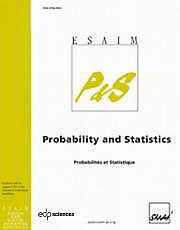Article contents
Number of hidden states and memory: a joint order estimation problem for Markov chains with Markov regime
Published online by Cambridge University Press: 21 February 2009
Abstract
This paper deals with order identification for Markov chains with Markov regime (MCMR) in the context of finite alphabets. We define the joint order of a MCMR process in terms of the number k of states of the hidden Markov chain and the memory m of the conditional Markov chain. We study the properties of penalized maximum likelihood estimators for the unknown order (k,m) of an observed MCMR process, relying on information theoretic arguments. The novelty of our work relies in the joint estimation of two structural parameters. Furthermore, the different models in competition are not nested. In an asymptotic framework, we prove that a penalized maximum likelihood estimator is strongly consistent without prior bounds on k and m. We complement our theoretical work with a simulation study of its behaviour. We also study numerically the behaviour of the BIC criterion. A theoretical proof of its consistency seems to us presently out of reach for MCMR, as such a result does not yet exist in the simpler case where m = 0 (that is for hidden Markov models).
Information
- Type
- Research Article
- Information
- Copyright
- © EDP Sciences, SMAI, 2009
References
- 2
- Cited by

